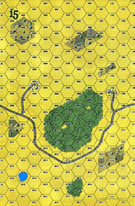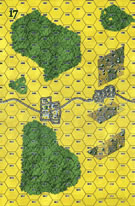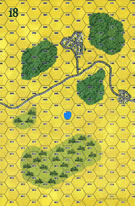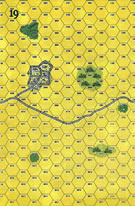|
Common Cause Iron Wolves #4 |
||
|---|---|---|
|
(Attacker)
Germany
(Attacker) Lithuania |
vs | Poland (Attacker) |
| Formations Involved | ||
|---|---|---|
| Germany |  |
1st Cavalry Division |
| Lithuania |  |
Cavalry Division |
| Poland |  |
Suwalki Cavalry Brigade |

| Total | |
|---|---|
| Side 1 | 1 |
| Draw | 1 |
| Side 2 | 0 |
| Overall Rating, 2 votes |
|---|
|
3.5
|
| Scenario Rank: --- of 913 |
| Parent Game | Iron Wolves |
|---|---|
| Historicity | Alt-History |
| Date | 1939-09-01 |
| Start Time | 08:00 |
| Turn Count | 18 |
| Visibility | Day |
| Counters | 95 |
| Net Morale | 0 |
| Net Initiative | 1 |
| Maps | 4: 15, 17, 18, 19 |
| Layout Dimensions | 86 x 56 cm 34 x 22 in |
| Play Bounty | 176 |
| AAR Bounty | 171 |
| Total Plays | 2 |
| Total AARs | 1 |
| Battle Types |
|---|
| Meeting Engagement |
| Conditions |
|---|
| Off-board Artillery |
| Scenario Requirements & Playability | |
|---|---|
| Eastern Front | Counters |
| Iron Wolves | Base Game |
| Road to Berlin | Maps |
| White Eagles | Counters |
| Introduction |
|---|
|
Fearing security leaks, the Germans did not approach the Lithuanians until after their attack on Poland was under way. Therefore, as with their Slovak allies on Poland's southern border there was no joint planning before the attack. But Lithuania did have a mobile formation that would have been useful if joined with the German Army's similar brigade. |
| Conclusion |
|---|
|
Lithuania decided against aligning itself with Germany, leading to occupation by the Soviet Union and loss of the nation's independence. But personal freedom had already been lost, and after 1926 the only question was the language of oppression. The German cavalry brigade was simply not as good as its Lithuanian or Polish counterparts. |
| AFV Rules Pertaining to this Scenario's Order of Battle |
|---|
|
| 3 Errata Items | |
|---|---|

|
The reduced direct fire value of the Heer HMG became 5-5 starting with Fall of France. (plloyd1010
on 2015 Jul 31)
|

|
The movement allowance on the counters in Airborne is misprinted. It should be "3." (rerathbun
on 2012 Jan 30)
|

|
One unit of Polish Calvary from White Eagles has a printed movement of 5, it should be 6 like the rest. (garbare83686
on 2023 Aug 13)
|
| They really do shoot horses |
|---|
|
Lithuanian, German and Polish cavalry clash in a wildly messy fight. The final score of this one was Axis (Lithuanian and German) 33, Polish 30. the Germans and Poles enter the largish mapboard directly across from each other and only an initiative roll for the Axis on Turn 2 permitted the capture of a two hex town by the Germans to establish an early 24-8 lead for the Axis (two points per town hex). If the Poles (who had a 4-3 edge in initiative had won the initiative they would have held the town and the Axis lead would only have been 20-12. Given the superiority of the Polish troops as opposed to the Germans it seems likely that the Poles would have held the town and been in great position to fight off the Germans. That is, of course, speculation. What did happen is that the Poles got organized for an assault towards the Germans and to their complete surprise needed to turn to fight the Lithuanians who were attacking after only an hour and a half. By turning the Poles attention to the Lithuanians the attack on the Germans was halted and a draw created. It took the Poles the better part of three hours to stop the Lithuanians and by that time there was no time to turn to attack the Germans again. Even at this, the Lithuanians and Germans had a period in the middle of the game where they had such stunningly marvelous luck with the dice that one had to feel that they could pull the win (1/2 way through the Axis led 31-16) Tactically both sides gleefully pounded the other with artillery. All the troops were cavalry and were especially vulnerable to artillery. This even prompted both sides to hit assault hexes with artillery if they had a "morale advantage" and felt that they could cause demoralization and/or loss by the artillery fire. If either side had infantry it is clear that the infantry would have crushed the cavalry since it would not have had the fire penalty of the cavalry. This was a wonderful scenario to try out your cavalry tactics and frankly quite suspenseful. With a little luck the Poles would have won. |
| 0 Comments |

 IrWo003
IrWo003 




























